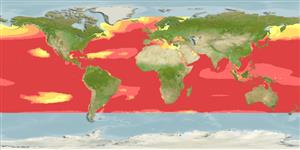Teleostei (teleosts) >
Lampriformes (Velifers, tube-eyes and ribbonfishes) >
Lampridae (Opahs)
Etymology: Lampris: Greek, lampros = light (Ref. 45335).
Environment: milieu / climate zone / depth range / distribution range
Ecology
Marine; bathypelagic; oceanodromous (Ref. 51243); depth range 0 - 500 m (Ref. 89422), usually ? - 366 m (Ref. 5951). Deep-water; 75°N - 60°S, 180°W - 180°E
Worldwide in tropical to temperate waters (Ref. 57923). Western Atlantic: Grand Banks and Nova Scotia (Canada) to Florida (USA), Gulf of Mexico and the West Indies (Ref. 7251) up to Argentina (Ref. 47377). Eastern Atlantic: Norway and Greenland to Senegal (Ref. 6737) and south of Angola (Ref. 6476) also Mediterranean. Eastern Pacific: Gulf of Alaska to south of southern California (Ref. 265). A single capture in South Georgia marks an incidental occurrence in Southern Ocean.
Size / Weight / Age
Maturity: Lm ? range ? - ? cm
Max length : 200 cm TL male/unsexed; (Ref. 5188); common length : 120 cm TL male/unsexed; (Ref. 5217); max. published weight: 270.0 kg (Ref. 5188)
Dorsal spines (total): 0; Dorsal soft rays (total): 48 - 55; Anal spines: 0; Anal soft rays: 33 - 41; Vertebrae: 43. Caudal fin broadly lunate; pectorals long and falcate; pelvic fins similar to pectoral fins in shape and a little longer (Ref. 6885). Dark steely blue dorsally shading into green with silver and purple iridescence, belly rosy, body covered with silvery spots in irregular rows, light mottling on caudal and dorsal fins; vermillion on fins and jaws, golden around eyes (Ref. 6885).
Oceanic and apparently solitary (Ref. 6737). Epi- and mesopelagic (Ref. 58302). Feeds on midwater fishes and invertebrates, mainly squids (Ref. 6737). Probably spawns in the spring (Ref. 6885). Occasionally taken as a by-catch of tuna fisheries. Considered a good food fish (Ref. 5242); marketed fresh and frozen; prepared as sashimi (Ref. 9987). Swims by flapping the pectoral fins (Ref. 36731).
Palmer, G., 1986. Lamprididae. p. 725-726. In P.J.P. Whitehead, M.-L. Bauchot, J.-C. Hureau, J. Nielsen and E. Tortonese (eds.) Fishes of the north-eastern Atlantic and the Mediterranean. UNESCO, Paris. Vol. 2. (Ref. 6737)
IUCN Red List Status (Ref. 130435: Version 2024-1)
Threat to humans
Harmless
Human uses
Fisheries: minor commercial; gamefish: yes
Tools
Can't connect to MySQL database fbquizv2. Errorcode: Too many connections
